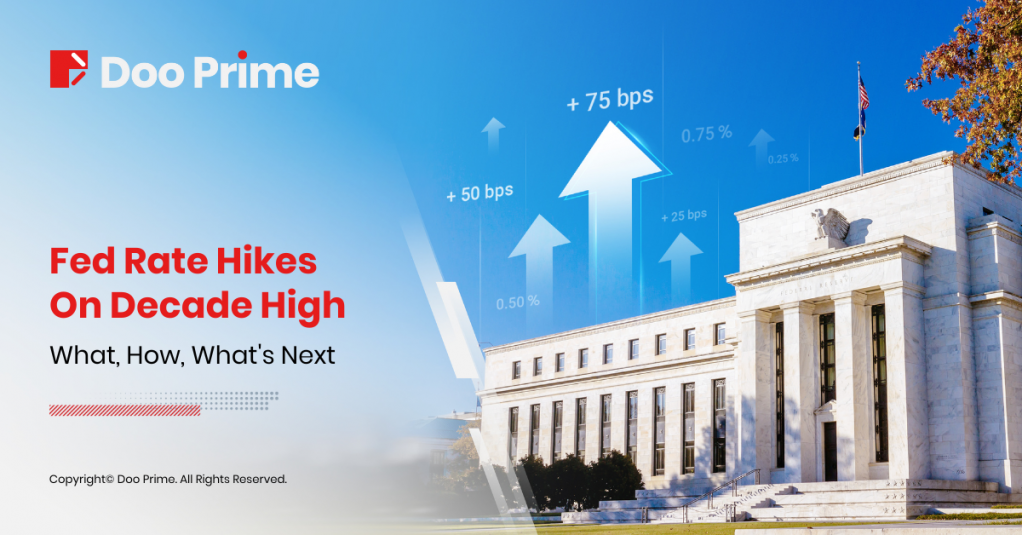
An Overview of The Fed Rate Hike In 2022
On 15th June 2022, the Federal Reserve announced that it will raise the target range of the federal funds rate by 75 basis points to a range of 1.5% – 1.75%. This is the Fed’s first 75 basis point rate increase in 28 years and the largest rate hike ever.
The U.S. CPI rose 8.6% year-on-year in May, a record high since December 1981. Some analysts believe that the Fed is currently in the middle of raising interest rates, and they are most likely to raise interest rates by 75 basis points in July. To add, even a 100 basis points cannot be ruled out.
This move is considered to be the Fed’s new strategy of “slowing down the economy and reducing inflation”, which will have an impact on the global economy and financial development, causing widespread concern and vigilance in the market.
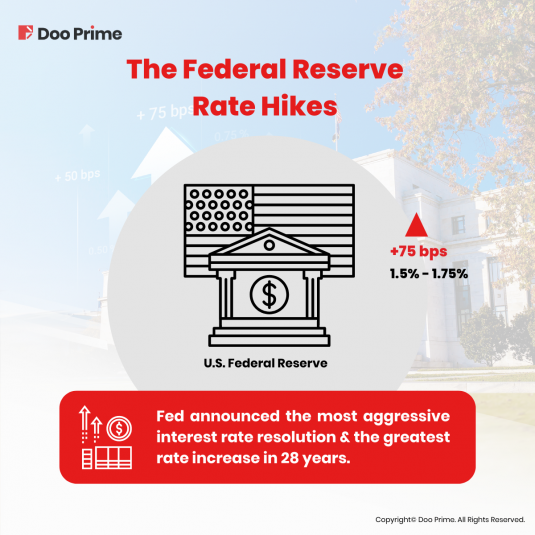
The Most Aggressive Rate Hike In Nearly 30 Years
In early March this year, the Federal Reserve started a monetary tightening cycle, raising interest rates by 25 basis points in March followed by 50 basis points in May.
Now, for the third time this year, comes an additional 75 basis point hike, which is also the largest rate hike since November 1994.
Since 2022, the Fed has raised rates by 150 basis points to a record high level since March 2020, before the pandemic hit.
The Fed believes that the upward price pressures may persist and is thus more wary of uncontrollable inflation expectations. In its statement on the rate decision, the Fed reiterated that the Federal Open Market Committee (FOMC) seeks to achieve the dual goal of full employment and long-term inflation of 2%.
Before we dive into what is going on with the Fed rate hikes, let’s have a quick run-through of what the Fed hikes are about.
The Federal Reserve’s duty is to keep the U.S. economy attuned—not too stagnant, not too unpredictable, but just right. When the economy booms and runs hot, distortions like inflation and asset bubbles can get out of hand, threatening economic stability.
That’s when the Fed comes in and raises interest rates, which helps ease the economy and keep growth on track.
When people talk about the Fed raising interest rates, they are referring to the federal funds rate, also called the federal funds target rate. At its regular meetings, the Federal Open Market Committee (FOMC) sets a target range for the federal funds rate, which acts as a reference for the interest rates big commercial banks charge each other for the overnight loans.
Thanks to this mechanism, the federal funds rate is the most important benchmark for interest rates in the U.S. economy—and it influences interest rates throughout the global economy as a whole.
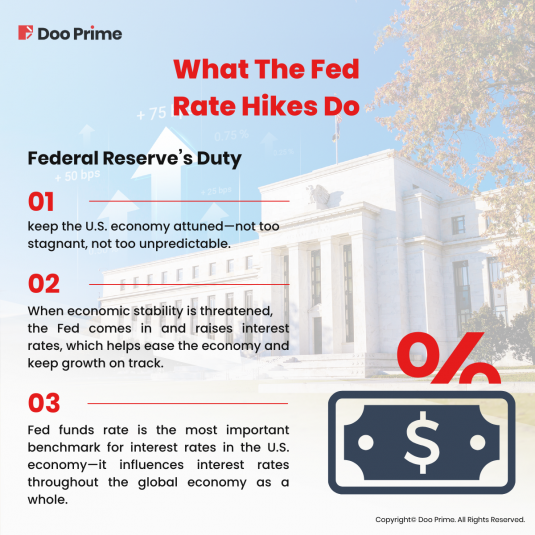
The Federal Reserve Raised Interest Rates To Contain Rampant Inflation
Last week, the June FOMC meeting came to an end and the Fed officials ended their “silent period” by announcing a sharp interest rate hike of 75 basis points.
The Fed’s current rate-hike campaign, which began in March, is designed to ease the worst bout of inflation the U.S. has seen since the Volcker years. Volcker, 12th Fed chairman was widely credited with having ended the high levels of inflation seen in the United States throughout the 1970s and early 1980s.
Now, the Feds are targeting to counter the fastest pace of inflation in over 40 years with this hike, just as Volcker did.
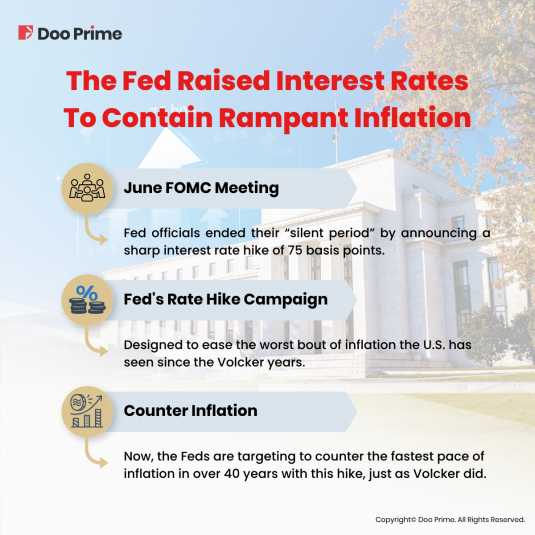
“Clearly, today’s 75 basis point increase is an unusually large one, and I do not expect moves of this size to be common,” Powell said. He added, though, that he expects the July meeting to see an increase of 50 or 75 basis points. He said decisions will be made “meeting by meeting” and the Fed will “continue to communicate our intentions as clearly as we can.”
Only a week ago, the Fed had been expected to raise rates by 0.5 percentage point at the last meeting. But markets and Wall Street economists began to expect the larger 0.75 point hike after the May consumer price data suggested inflation has been unexpectedly stubborn. At this point, some Wall Street analysts even argued a 1 percent point hike was possible.
The prospect of a faster pace of rate hikes due to inflation has prompted financial markets to plunge by over 6% since the 10th June report. Investors are also worried that the Fed may slow the economy too much in its fight to reduce inflation, which if left unchecked also poses serious problems for consumers and businesses.
With this, analysis pointed out that the report’s use of the word “unconditional” and Bostic’s use of the word “at all costs” indicate that the Fed is willing to risk an economic downturn to avoid runaway inflation.
How Will The Rate Hike Affect Investors & The Markets
Higher interest rates tend to negatively affect earnings and stock prices (often with the exception of the financial sector).
Plus, any impact on the stock market from a change in the interest rate is experienced fairly immediately.
In the days leading up to Wednesday’s meeting, stocks plunged following shockingly high inflation data from May. But now that the dust has settled and the rate hike has passed, the market’s reaction was slightly surprising.
At 3:10 p.m. (ET), the S&P 500 was up nearly 1.6%, while the tech-heavy Nasdaq Composite gained 2.6%. The 30-stock Dow jumped more than 350 points.
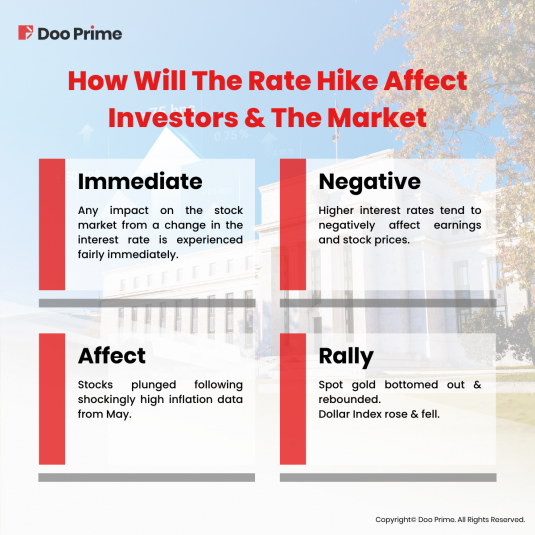
On the same day, stocks rallied slightly, reassured by the Fed’s position that their next rate hike will depend on upcoming data. Investors took this to mean that while the Fed was serious about inflation, they also weren’t willing to take any unnecessary risks that would plunge the economy into a recession.
In terms of the specific market trend upon the Federal Reserve’s June resolution, the spot gold price bottomed out and rebounded in short-term. The dollar index rose and fell, the euro rose against the dollar while the dollar rose and fell against the yen.
During this interval, the yield on the 10-year U.S. Treasury note rose to 3.425% and the U.S. stocks retreated after the volatility.
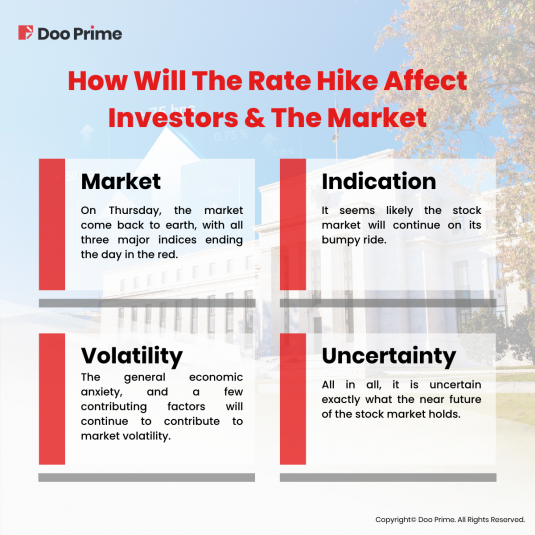
On Thursday, we saw the market come back to earth, as it was, with all three major indices ending the day in the red. Still, that is not entirely shocking, either, given the past few months’ performances.
If these two days are any indication, it seems likely the stock market will continue on its bumpy ride.
Ultimately, investors still have time to fully digest the Fed hike news and see where the economy will feel the impact. The general economic anxiety, the Russia-Ukraine war, soaring gas prices, and a market correcting from pandemic-era highs have (and likely will) continue to contribute to market volatility.
All in all, it is uncertain exactly what the near future of the stock market holds – but it seems likely that there’s still a little way to fall yet.
In-Depth Analysis On The Fed Rate Hikes
Now that we have all the facts laid out, let’s take a look at what Doo Prime’s in-house analyst, James Gomes, who has been in the finance industry for over 30 years, has to say about this ongoing rate hike.
Last week, the Federal Reserve raised interest rates by 75 basis points – the biggest increase since 1994.
In a post-meeting press conference, Chairman Jerome Powell said another 75-basis point hike or a 50-basis point hike was likely at the next meeting.
They forecast interest rates would rise even further this year, to 3.4% by December and 3.8% by the end of 2023. That was a big upgrade from the 1.9% and 2.8% that they penciled in for their March projections.
The latest increase and projections tell us how wrong the feds have been about inflation.
It also tells us how motivated they are to try and rectify their mistake.
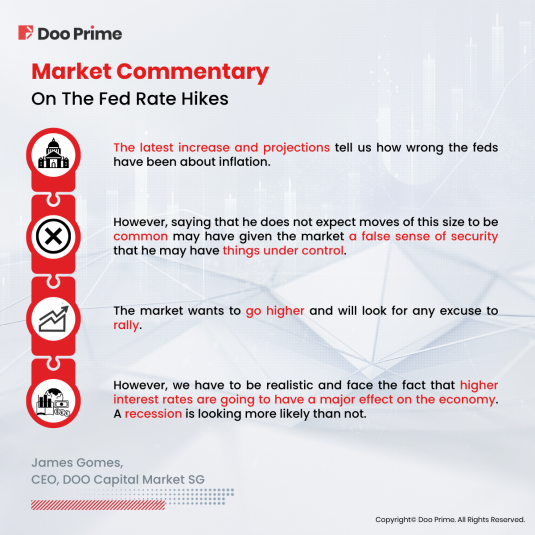
However, saying that he does not expect moves of this size to be common may have given the market a false sense of security that he may have things under control.
If anything, it might confuse investors. Powell’s press conference came across much less hawkish than the 75 basis point hike and projections he delivered.
It was almost like he was trying to say, hey I will raise rates quickly to fight inflation but don’t worry I won’t bring the economy down.
History shows that they have been behind the curve for a long time and chances are, they still have no idea how sticky inflation will be in the near future.
Preventing a recession while fighting a 40 year high inflation is not an easy task.
The market wants to go higher and will look for any excuse to rally. However, we have to be realistic and face the fact that higher interest rates are going to have a major effect on the economy. A recession is looking more likely than not.
What’s Next?
When the Federal Reserve raised interest rates last week by the largest amount since 1994, it did more than declare war on inflation.
Of course, not all Fed rate hikes are going to impact individuals directly, and not all corners of the financial world are going to be affected by rate changes.
But keeping tabs on changes to monetary policy is an important part of keeping financial life in order.
The latest move is only one part of a rate-hiking cycle, which aims to crush inflation without tipping the economy into a recession, as some fear could happen.
Even though the Fed has already raised rates multiple times this year, more hikes are on the horizon as the central bank grapples with inflation.
While expectations for those increases had been quarter and half-point hikes at each meeting, the central bank could hand out further 50 or 75 basis point increases if inflation doesn’t start to cool down.
Keep an eye on Doo Prime’s weekly market commentary and daily analysis on DooPrimeNews.com to stay abreast of this ongoing Fed rate hike.
Risk Disclosure
Trading in financial instruments involves high risks due to the fluctuation in the value and prices of the underlying financial instruments. Due to the adverse and unpredictable market movements, large losses exceeding the investor’s initial investment could incur within a short period of time. The past performance of a financial instrument is not an indication of its future performance. Investments in certain services should be made on margin or leverage, where relatively small movements in trading prices may have a disproportionately large impact on the client’s investment and client should therefore be prepared to suffer significant losses when using such trading facilities.
Please make sure you read and fully understand the trading risks of the respective financial instrument before engaging in any transaction with Doo Prime’s trading platforms. You should seek independent professional advice if you do not understand any of the risks disclosed by us herein or any risk associated with the trade and investment of financial instruments. Please refer to Doo Prime’s Client Agreement and Risk Disclosure Statement to find out more.
[Disclaimer]
This information is addressed to the general public solely for information purposes and should not be taken as investment advice, recommendation, offer, or solicitation to buy or sell any financial instrument. The information displayed herein has been prepared without any reference or consideration to any particular recipient’s investment objectives or financial situation. Any references to the past performance of a financial instrument, index, or a packaged investment product shall not be taken as a reliable indicator of its future performance. Doo Prime and its holding company, affiliates, subsidiaries, associated companies, partners and their respective employees, make no representation or warranties to the information displayed and shall not be liable for any direct, indirect, special or consequential loss or damages incurred a result of any inaccuracies or incompleteness of the information provided, and any direct or indirect trading risks, profit, or loss arising from any individual’s or client’s investment.